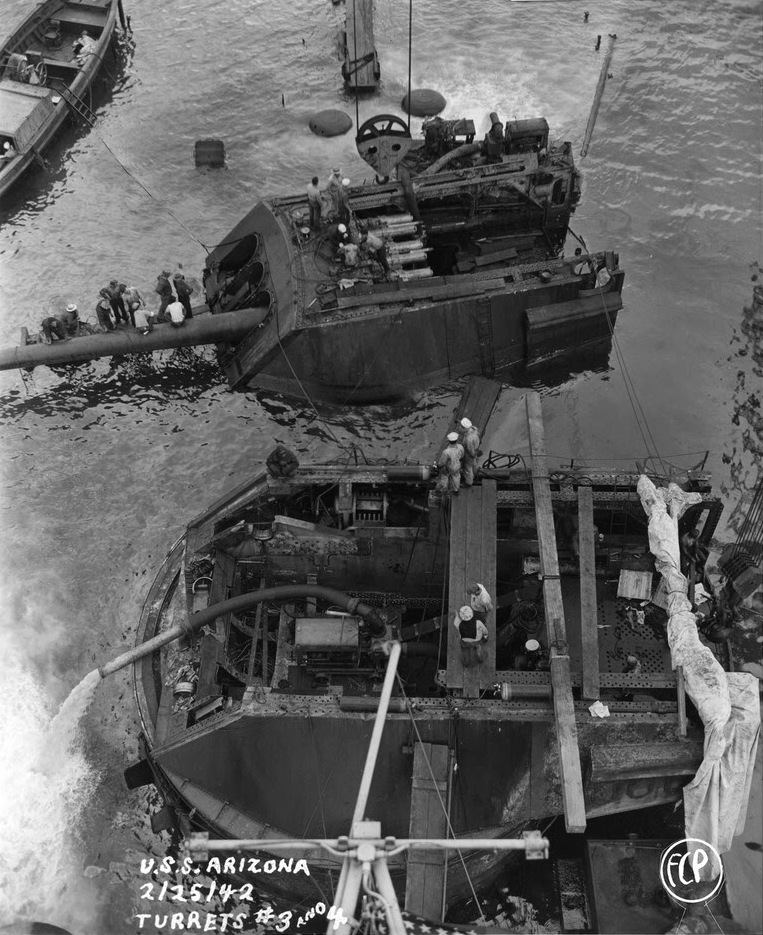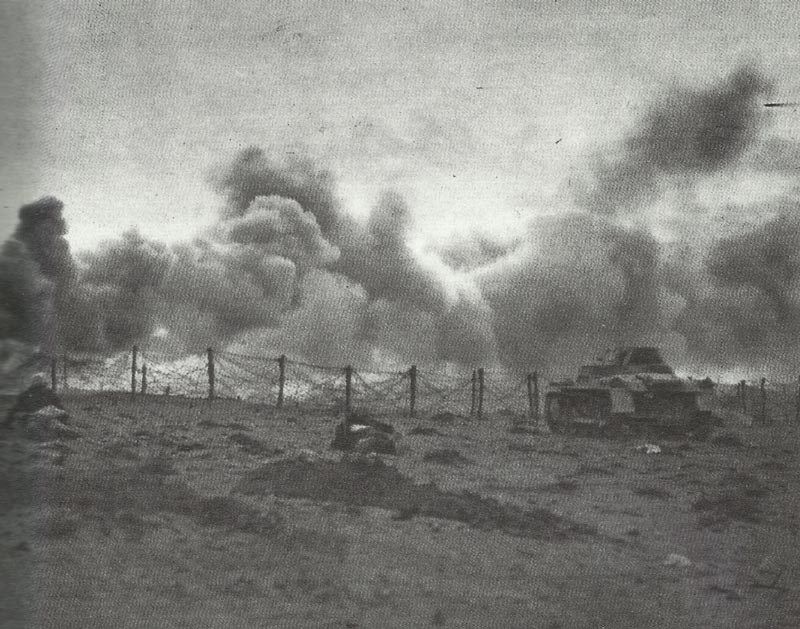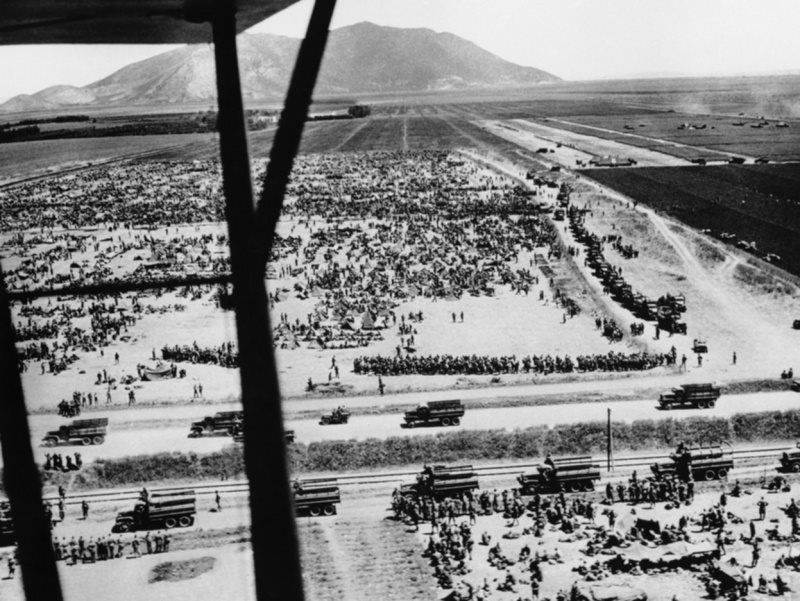I think Japan still would have invaded the Soviet Union though, if the Second Sino-Japanese War continued (the oil embargo only really happened once they invaded Indochina).
Other than that I agree with you. That would be curious alternate reality.
Raising the Flag on Iwo Jima.
This iconic photograph was taken by Joe Rosenthal 74 years ago on this day, February 23rd 1945. It depicts 6 US Marines raising an American flag atop Mount Suribachi, during the fierce Battle of Iwo Jima, Japan.
Colourised by Marina Amaral
February 25, 1945
US. Ensign Ardon Rector Ives #382583 of Rockford, Mich., appears to be calmly unbuckling his seat belt and readying to escape from his burning Grumman F6F-5 ‘Hellcat’ of VF-9 fighter carrier group.
His fighter burst into flames when it hit a barrier and other planes while landing on the USS Lexington (CV-16) on February 25 1945.
Ardon Ives was KIA in a dogfight with Japanese fighters just a few weeks later on March 18 1945, aged 23.
(Initially classified as MIA until May 22 1945)
Ensign Ardon Rector Ives, United States Navy, was awarded the Distinguished Flying Cross (Posthumously) for extraordinary achievement while participating in aerial flight as a Fighter Pilot embarked in U.S.S. Yorktown from 16 February 1945 to 18 March 1945.
He is buried in his home town of Rockford, Kent County, Michigan.
(Photo source - US Navy)

Salvage work continuing on the sunken battleship USS Arizona in Pearl Harbor, Hawaii, 25 February 1942. Note Arizona’s two after main turrets being pumped out and disassembled.
February 25, 1945
USMC 5th Division Marines grouped behind their Browning M1919 .30 calibre machine gun, display Japanese battle flags captured during the first few days of the bloody fight for Iwo Jima.
It was the men of the Fifth who fought their way to the top of Mount Suribachi to raise the American flag on the rim of the crater.
The 5th Division landed on Iwo Jima on February 19, 1945, southeast of Mount Suribachi. The division sustained heavy initial losses, so much so that by that afternoon, the 26th Marine Regiment had to be released as the division reserve.
On February 23, two American flags were raised on Mount Suribachi by members of the 28th Marine Regiment. The 5th Division would fight on Iwo Jima from February 19 until March 26 where they would sustain 2,482 killed in action, 19 missing in action, and 6,218 wounded in action. This was the highest casualty rate among the three Marine divisions involved in the invasion.
(U.S. Navy Official photograph)

@captain-walker
wow that’s gotta be close to a 50% casualty rate for the 5th
1943:
The battle of Kasserine ends when the city is occupied by the Allies. Axis attack causes roughly 10,000 casualties against 2,000 Axis dead.
The RAF begins ‘round the clock’ air offensive over Europe. Nuremberg heavily bombed at night.
Men of the 2nd Battalion, 16th Infantry Regiment of the U.S. 1st Infantry Division march through the Kasserine Pass, Tunisia. February 26th 1943.
26 February 1942
Indian ocean: American seaplane tender Langley, on the way to Java, is sunk by Japanese air action.
North Africa: British XIII Corps take up positions on the Gazala-Bir Hacheim line; XXX Corps prepares a defensive line on Egyptian frontier and in the Jarabub oasis. British aircraft bomb Benghazi and Tripoli 2nd day straight.
Philippines: Japanese amphibious troops leave Luzon for Mindoro.
@Phelan-Kell said in On this day during W.W. 2:
26 February 1942
Indian ocean: American seaplane tender Langley, on the way to Java, is sunk by Japanese air action.
I once saw a two-part, 1960s-ish US Navy documentary about the evolution of aircraft carriers and it mentions the USS Langley, a.k.a. CV-1, the USN’s first carrier (and, as a footnote, also the USN’s first ship with turbo-electric propulsion). Its capacities were limited, but it was only meant to serve as an experimental platform for the development of carrier technology, operational techniques and doctrine, and much was learned from those early pioneering days. The documentary’s narrator has a memorable line in which he says that, decades later, it was a source of great pride for a dwindling number of grey-haired naval aviators to say to their younger buddies, “I flew from the Langley.”
April 20, 1945 Battle of Berlin
It’s Adolf Hitler’s 56th birthday and the Soviets send their regards by bringing their artillery in range of the city center. The shelling did not stop until the city surrendered.
After a brief birthday celebration, the generals urged Hitler to flee Berlin for southern Germany to continue the fight.
The 1st Belorussian Front advanced towards the east and north-east of the city, the 1st Ukrainian Front pushed through the last formations of the northern wing of Army Group Centre and passed north of Juterbog, well over halfway to the American front line on the river Elbe at Magdeburg.
To the north between Stettin and Schwedt, the 2nd Belorussian Front attacked the northern flank of Army Group Vistula, held by Hasso von Manteuffel’s III Panzer Army.
April 30, 1941. North Africa
Rommel gets Paulus’ permission to attack Tobruk. At 2000 hours, German tanks break through the perimeter under cover of dark and an artillery barrage, Overnight, German infantry overrun several Australian gun posts but some hold out, preventing a complete collapse of the defences. To their right, Italian Brescia Division fails to break in.
Photo: German infantry assault party with tank support on its way through the wire obstacles in front of Tobruk.
Source: worldwar2daybyday
It’s ironic that Friedrich Paulus was sent (as an OKH staff officer) to consult with Rommel in April 1941 with regard to the Tobruk operation because a couple of years later there was another overlap between the two officers. The Stalingrad campaign was on its last legs in early 1943, with Paulus and his staff surrendering on January 31st. At the same time, the North Africa campaign was winding down: Tripoli fell to the Allies on January 23; the Allies entered Tunisia in March, and Rommel left for Germany on March 9. Both defeats were bad news for the Axis side.
@CWO-Marc Nice observation, Marc.
5/3/1945
A BF-109-E was successfully grown from root stock.
May 6, 1940. Norway
At Narvik, the Allies tighten the noose around General Dietl’s Regiment. South Wales Borderers (part of British 24th Brigade) are in position 5 miles West of Narvik, while French Chasseurs Alpins and Colonial artillery troops continue to press their attack on Labergdal Pass to the North, across the fjord. Both are held by German perimeter forces. However, Germans bomb Allied ships near Narvik. British cruiser HMS Enterprise is slightly damaged by a near miss (1 Marine killed).
German 2nd Gebirgsjäger Division continues their slow march North from Trondheim to reinforce Dietl’s Regiment.
At 1400 hours, British submarine HMS Sealion attacks German transports Moltkefels and Neidenfels in the Skagerrak. Sealion fires 6 torpedoes, claiming three hits. But all torpedoes miss the targets and the transports are not damaged.
At 1525 hours 30 miles East of Denmark, British submarine HMS Snapper fires 2 torpedoes at German armed merchant cruiser Widder but both miss.
Photo: French troops in the Narvik sector, 1940.
Source: worldwar2daybyday

May 13, 1940. Western Front
Northern France. In the morning, Rommel sends motorcycle troops across the Meuse River over a weir & lock gate at Dinant, while Guderian’s troops cross in rubber boats at Sedan in the afternoon following intensive bombing of French defensive positions. Despite French artillery bombardment, they both establish bridgeheads and by the evening they have pontoon bridges in place and tanks are rolling over.
Holland. German 9th Panzer Division reaches the outskirts of Rotterdam and 22nd Flieger Division holds onto bridges in the city. Dutch Queen Wilhelmina leaves at noon on HMS Hereward. Her government exiles to London at 17:20 hours on HMS Windsor.
Belgium. Battle of Hannut continues. To cover the Gembloux gap, French tanks line up abreast in a long thin line. Large groups of Panzers easily punch through, causing havoc in the French rear and Prioux retreats to the defensive line at Gembloux. Over 2 days French lost 105 tanks, Germans 160.
Winston Churchill first enters the House of Commons as Prime Minister, accompanied by his predecessor Chamberlain who receives a better reception by far. Churchill gives his “Blood, toil, tears and sweat” speech.
Photo: A Panzer II and other motorised units of the 10th Panzer Division at Wadelincourt, head for the Meuse River on the left flank of the German assault during the Battle of Sedan. May 13 or 15, 1940
Colourised by Royston Colour

Panorama of German and Italian prisoners in Tunisia after the capitulation of the African Corps on May 13, 1943.
May 14, 1942. Eastern Front
Second Battle of Kharkov. Soviets continue advancing West out of the Izyum salient, but Soviet 28th Army, forming the Northern pincer advancing from another salient near Volchansk, is pounded to a standstill by Luftwaffe Fliegerkorps VIII, newly-arrived from the Crimea. Soviet fighters sent in to engage the Germans are decisively beaten despite being numerically superior. Hitler orders General Ewald von Kleist to counterattack with his 1st Panzergruppe. In the Black Sea, Soviet destroyer Dzerzhinski sinks on a Soviet mine near Sevastopol.
Source: worldwar2daybyday

@captainwalker Stukas: now I am excited!
@Wittmann said in On this day during W.W. 2:
@captainwalker Stukas: now I am excited!
And on that subject, note that the photo correctly shows (for the spring 1942 period) conventional Stukas, not the Ju 87G Kanonenvogel tankbuster version which entered service about a year later and first went into combat at Kursk. The Ju 87G is easily recognizable by its large underwing 37mm cannon pods. To put things in perspective, this was the same caliber gun which was the main weapon of the early versions of the Panzer III.